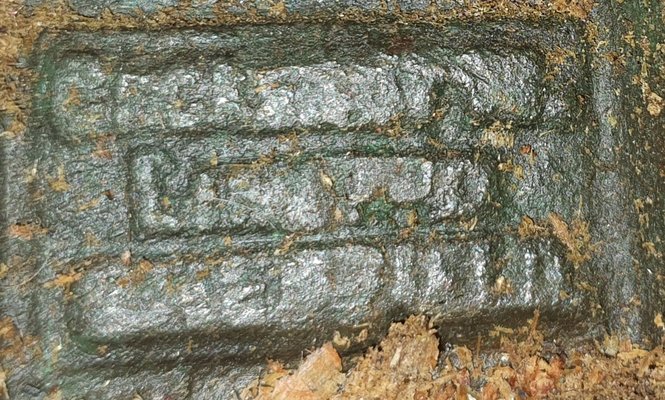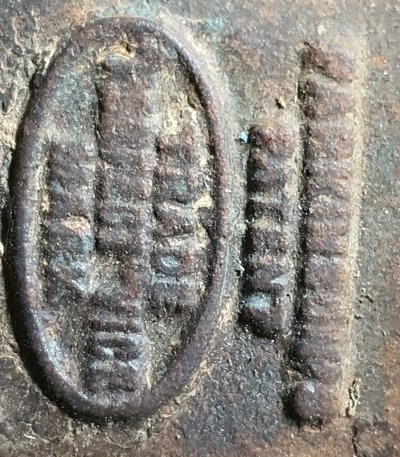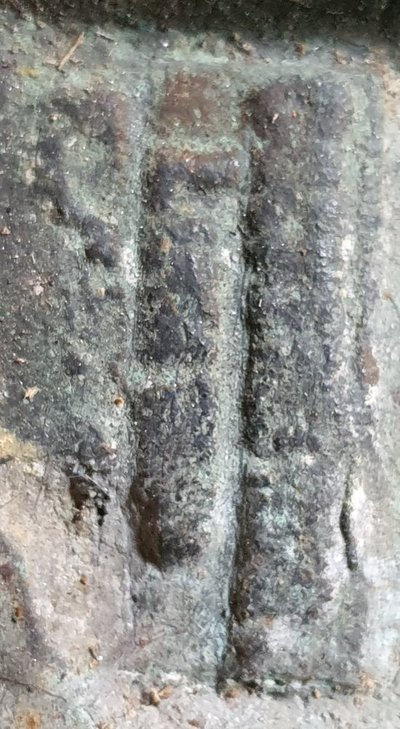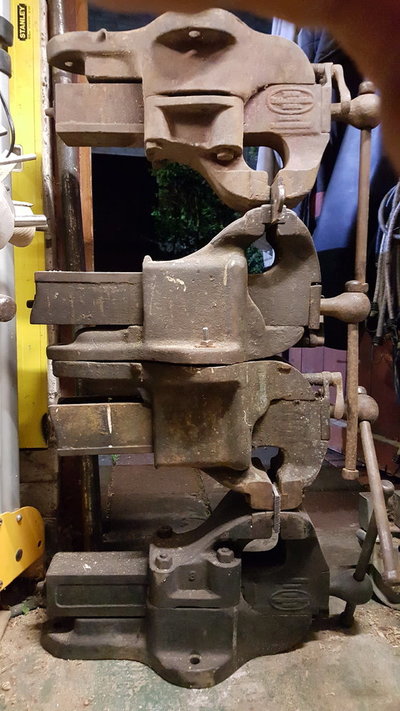Arc Tourist
Member
- Messages
- 4,929
- Location
- Wales
Can you tell if the thread is cut with a 60* angle, or a 55* angle thread ?
 Thank you!
Thank you!

Perhaps the screw was cut down from a longer machine screw which did not have threads cut on the entire shaft.................................................
Now he had a nice M6 female thread .... but how did he get a new M6 male thread on the worn 1/4" screw?
Outside diameter M6 is 6mm.
Outside diameter 1/4" is 6.35mm ... but this thread had to be very worn already, otherwise he wouldn't have done anything.
..............................................how did the guy manage to get a healthy M6 external thread????
Ideas? Thanks.
Night,
Carsten
--
I don't know about you, but I see two different threads on the bolt ...
25.4
Bit late to the game here but as a few others know I came across an unusual parkinson which has the front plate which looks like it should have a QR but when you look at the rest of the components it would never have had one fitted. Perhaps yours never had a working QR?
View attachment 315060View attachment 315061View attachment 315062View attachment 315063View attachment 315064View attachment 315065View attachment 315066
The tapering of the machine screw was known as 'waisting' when I was a fitter. It is caused by bolts tightened too tightly or excessive tensile stresses. It makes the bolts useless and they should be replaced. As to what they are, I don't know, I'd begin with thread gauges and then work on to taps and dies until I found the correct size. But IMO the m/c screws need replacing, no tarting up.puuuh, that was a bit shady outside and in the barn, clear sky, the moon very bright and close, that could give the first ground frost this night ...
Thank you very much for your diligence, Steve.
Then it's not as complicated as I had imagined, you can work with it quite well.
It's also funny that with the factor of 40 the thousandth of an inch comes to roughly 1mm over the thumb.
Not bad, nice punch line, Matt.
So we see it all quite casually today, a bit more relaxed ...
... what's 1/8 between friends ...
Of course, Breitenfeld & Scholz didn't have anything like that in Bunzlau in southern Silesia, today known as Bolesławiec.
I just measured the jaws of the 150mm Eikar "E" in passing: 150mm, full stop!
View attachment 315034
It's not that easy with the Parkinson suspect.
The cover nuts were ok, 7/8" spanner size, 14G/" should amount to 7/16".
With the screws that hold the QR on the other hand:
View attachment 315016
I don't know about you, but I see two different threads on the bolt ...
so it's better to clean them properly first.
After
brake cleaner,
toothbrush,
grease solvent,
citric acid,
ultrasonic bath,
you can see more clearly:
View attachment 315022
Indeed, M6 at the bottom, but 19G/" at the top ...
However, I did not find 19G/" in any of the tables for Witworth standard threads except for pipe threads, a completely different animal and much larger.
With more light and stronger reading glasses, I have now settled on 20G/", which brings us to 1/4" thread.
But how on earth does the M6 thread get onto the 1/4" bolt?
Shouldn't one assume that there wouldn't be much material left over from the attempt alone? But here it seems to have become more material ...?!?
Did someone roll an M6 thread onto it? How? Only on the lower part of the bolt?
Does anyone have any ideas?Thanks.
Have a good evening everyone,
Carsten
--
It does say 'VICE' not 'VISE', I just checked.Yes, remember this, v. interesting, and the marking with 'vise' is not like the earliest with 'vice', but the 'Parkinson's' has apostrophe, so before JP's sons joined the board, say about 1895-1900?? -- but no-one would design a non-QR with a buttress thread, I'd think, and the marking does say 'Perfect', which meant QR.
I've just realised another point with yours - the bottom section of the two part static does not have 'walls' like my older 9 or the different inside 'hollow' section of 25.4's ie diff break line? were others of this time similar?
Sometimes transitional or experimental vices were allowed to 'escape' , maybe these are both examples?
I have two woodworking vices with a possible similar history - one a very solid non-QR looking a bit like the wonderful Woodhead vice of about 1860 but with a wheel instead of Tommy bar (like modern Benchcrafted) however two key bolt holes were never drilled and it must have spent over 150 years with a cobbled clamp and the other like a Parky QR but no markings and a very fine-grained cast finish - to be shown some other time.



Bottom line says Sheffield, not sure about the rest sorryIt does say 'VICE' not 'VISE', I just checked.
I'm still not able to make out the writing on the static jaw though, looks like the first line begins with a C
View attachment 315113
but no-one would design a non-QR with a buttress thread,
True, from memory buttress threads cope better with axial thrust in a single direction, that is in the direction of the thread, which leads to a more positive grip in the jaws. They also have a higher tpi which means you are able to get more movement per turn of the handle. Buttress threads are as efficient as a square thread in the direction which they are designed to apply load while being easier to manufacture.Not necessarily. The buttress threadform is far more suited to vices than square or acme.
Ok ,,, buy that, but almost all non QR bench vices made were acme or similar flat top, and machine vices often a v profile.Not necessarily. The buttress threadform is far more suited to vices than square or acme.
Yes, and middle line LIMITED? so who? Maybe this was a special for a Sheffield retailer or tool maker.Bottom line says Sheffield, not sure about the rest sorry
Ok ,,, buy that, but almost all nonQR acme or similar, and machine vices often a simple v
It does say 'VICE' not 'VISE', I just checked.
so maybe pre ~1896? ds
Those are either screws which have stretched, else just suffered wear where they pass through the plate.
The tapering of the machine screw was known as 'waisting' when I was a fitter. It is caused by bolts tightened too tightly or excessive tensile stresses. It makes the bolts useless and they should be replaced. As to what they are, I don't know, I'd begin with thread gauges and then work on to taps and dies until I found the correct size. But IMO the m/c screws need replacing, no tarting up.
Does booze count as food?Many life forms use Gold leaf. I am just the only one on here to openly use it.
In fact I bet that there are some who have smoked it.
As long as you do not put it on food.

Not at all.Does booze count as food?
"Goldschläger Cinnamon Schnapps Liqueur - Master of Malt" https://www.masterofmalt.com/liqueu...9l5T5iW3-hfSgPWtlmoRYwYCpMlg3GPhoC0wwQAvD_BwE
The vise that most resembling mine so far turned up in Australia (Differences: parting line at the bottom, no anvil area, nut on spindle end)
View attachment 315149
This image is from a request made by user Opalwood on 2016-03-09 in this thread
No clarification could be obtained at the time, user Opalwood has not been active here since May 2016 and has not yet responded to an enquiry.Parkinson Vise i.d. ?
Hey Guys - i have had this vice offered to me but i am struggling to find any other models like it - does anyone know what model and approx age it would be ? Sorry don't have any sizes other than the can as a reference - also any thoughts on its condition would be appreciated. Many thanks Shane.www.mig-welding.co.uk
Apologies Carsten, I'd missed the part where you were looking for a high dividing line. You'll see two of that style in this picture of mine.Of course, these screws are no longer good and should be replaced.
This has been done and if it seems worthwhile, I will also make screws in the old look.
For now there is no danger!
View attachment 315139
But it was never the question what should happen with these screws but what kind of vise this is.
It was suggested here to take some measurements to see if it is more metric or imperial:
- The jaws are a little over 6 inches, which has been described as common here, but the same value as 156.35mm is not common in the metric world;
- The two U-bolts that clamp the part with the static jaw down have W7/16" threads, the four nuts have a 7/8" spanner size;
- The three screws that attach the front plate with the QR to the vise now have M6, I suspect however that was originally W1/4".
The vise that most resembling mine so far turned up in Australia (Differences: parting line at the bottom, no anvil area, nut on spindle end)
View attachment 315149
This image is from a request made by user Opalwood on 2016-03-09 in this thread
No clarification could be obtained at the time, user Opalwood has not been active here since May 2016 and has not yet responded to an enquiry.Parkinson Vise i.d. ?
Hey Guys - i have had this vice offered to me but i am struggling to find any other models like it - does anyone know what model and approx age it would be ? Sorry don't have any sizes other than the can as a reference - also any thoughts on its condition would be appreciated. Many thanks Shane.www.mig-welding.co.uk
Last found advertisement in 1902 for a Parkinson with separable static enclosure, here high dividing line,
found at: https://www.gracesguide.co.uk/File:Im190201Cass-Park.jpg
View attachment 315151
It is important to remember that this is not a photograph but an artistic impression.
Later
Carsten
--





